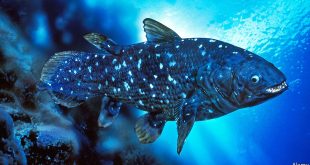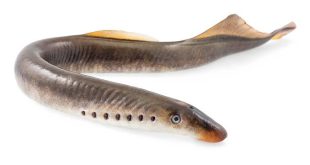Apart from the special case of the channichthyid icefishes, most oxygen in the blood is carried by red cell hemoglobin, oxygenated when Po2 is high and deoxygenated when it falls, according to the oxygen dissociation curve (blood Po2 plotted against the amount of O2 bound to the hemoglobin). Oxygen dissociation …
Read More »Tag Archives: fish
Introduction to Coecalanth
The living Latimeria chalumnae was first identified off Southern Africa in 1938, and was known from some 200 further specimens all caught off the volcanic islands of the Comoro archipelago near Madagascar until a large female was trawled off Mozambique in August 1991. Further search produced more off Sulewesi which …
Read More »Introduction to Holostei & Teleostei
Holostei Even fewer holosteans than chondrosteans survive today. The bowfin (Amia) of rivers in eastern North America, and seven species of garpikes (Lepisosteus and Atractosteus) from fresh and brackish waters of North and Central America, are all that remain. Garpikes are more primitive than Amia, and, as form the sister group …
Read More »Introduction to Chondrostei
The surviving 25 species of chondrostean fishes are divided between the bichirs and reedfishes (18 extant species of the genera Polypterus and Erpetoichthys) in the Brachiopterygii, and the acipenseriform sturgeons and paddlefishes (Acipenser, Polyodon, and Psephurus). Both groups share primitive characters such as spiracles and a spiral valve, but Polypterus …
Read More »Introduction to Lungfish
Six species of lungfish in three genera survive today from a group that appeared in the Devonian and was widespread in the Paleozoic. Modern lungfish are in several ways at once specialized and simplified versions of their more completely ossified ancestors. The Australian (Queensland) Neoceratodus is the most heavily ossified …
Read More »Distribution of Lampreys
Lampreys share with gnathostomes a more advanced kidney than hagfish, a pho-tosensitive pineal, a lateral line, radial muscles in the fins, functional eyes, extrin-sic eye muscles, neural and hemal vertebral elements formed around the notochord, and similarities in pituitary histology. These features have strongly suggested to some that hagfish is …
Read More »Distribution of Myxinoids
Until fairly recently, myxinoids and lampreys were regarded as being sepa-rately derived from fossil agnathan groups, but some workers provided mor-phological evidence for their closer relationship (e.g. Yalden, 1985), and the advent of molecular taxonomy has supported this, so they now lie together for most ichthyologists as a sister group …
Read More »Internal Features of Fish
In all fish, the body is built around an axial notochord, still present in adult agnathans, sturgeons, and Latimeria, but more or less reduced in most adult fish by the development of vertebral elements around it. This provides the incompressible strut flexed by the serial myotomal muscle blocks, and pro-tects …
Read More »Structure of Fish: Body Shape, Scale and Fins
The ancient fish ancestors were presumably small and fusiform, looking somewhat like amphioxus (Branchiostoma), and many modern fish have retained this streamlined kind of shape, built around an axial notochord, more or less reduced in most by the development of vertebral elements around it. But every other kind of body …
Read More » EazyBio: Educate, Elevate, Empower EazyBio: Educate, Elevate, Empower
EazyBio: Educate, Elevate, Empower EazyBio: Educate, Elevate, Empower








